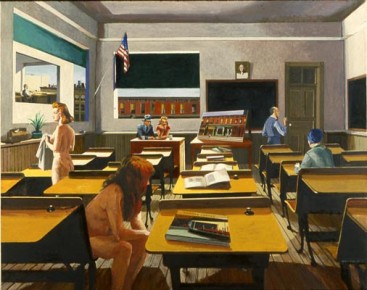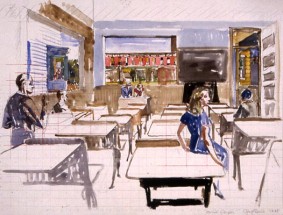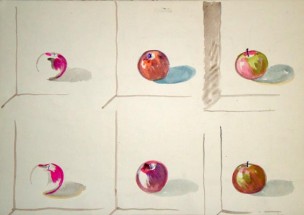| WorkSchool of Hopper
| Image Notes
The works of Edward Hopper (1882-1967) have... been dissected and then mixed together with each other by way of pastiche in a meta-artistic rather than satiric manner in George Deem's School of Hopper of 1985. There the man and the woman from Edward Hopper's Nighthawks' cafe of 1942 are shown seated together at the teacher's rostrum before a row of school desks like those that are to be found in the many other of the "schools" of art that are to be found in Deem's Art School of 1993. Before the viewer, at the end of one line of desks covered with books, lies a book on Hopper with his painting Nighthawks on its cover. Seated next to it is the figure of the seated nude from Hopper's Eleven A. M. of 1926, who now gazes at the reproduction of Hopper's Nighthawks rather than at the city scene suggested by her bedroom window. As Irene McManus points out in her Introduction to Deem's Art School, the allusion to Hopper's Eleven A.M. ironically points to the time at which the scene is set, Deem having claimed that the scene represents an Art School for those who can only meet on a Sunday morning. (See the Introduction to George Deem, Art School, by Irene McManus, p. 9f. Deem is also quoted by McManus as suggesting that the school's subjects will be "Depression-era lessons like crime and prostitution."). Various other quotations from Hopper's works are scattered about the schoolroom, providing figures as well as decorative details for Deem's work. One other Hopper nude -- appropriately enough from his Morning in a City of 1944 -- stands to the left of the scene, her empty bed replaced by the desks of the schoolroom, while the window next to that through which she gazes looks onto the scene from Hopper's Office in a Small City of 1953. Despite these figures having been brought together, the sense of social alienation found in Hopper's works is maintained rather than undermined in Deem's juxtaposition. To the right of the classroom one of the girls from Hopper's Chop Suey of 1929 is seated with her back to us at a desk -- as Hopper had formerly shown her seated at her restaurant table at the right hand side of his Chop Suey -- but alone, her companion having disappeared. The figure of the man in front of her smoking in Deem's School of Hopper has stepped out of the hotel room in Hopper's Hotel by a Railroad of 1952 and is now also a lone figure. Only the two figures from Nighthawks make a couple as they sit together at the teacher's desk at the top of the room, although the other inhabitants of the cafe are missing. Hopper's cityscape, his Early Sunday Morning of 1930 rests on an easel at the front of the classroom as if to tell us that the lesson is one in the depiction of emptiness, and also provides the backdrop beneath the half-drawn-down blind in the window behind. The pot plant beneath the window showing us Hopper's Office in a Small City has been borrowed from yet another Hopper painting, Sunlight in a Cafeteria of 1958, the arrangement of tables in which also suggests the arrangement of school desks that is to be found in Deem's School of Hopper. As with most pastiche that is not also parody, Hopper's individual figures are not re-painted with any obvious comic distortion or change. As a whole, moreover, Deem's pastiche may be described as being an exercise in displacement and unexpected rearrangement or juxtaposition that recreates the mood of the original works rather than comically breaking with it. (McManus in Deem op. cit., p. 11 also notes that Deem has described himself as a "juxtapositionist".). In that Deem's pastiche of Hopper is placed, like the others in his ArtSchool, in a schoolroom, its figures also function as both part of that schoolroom scene and as part of the instruction of the reader/spectator of Deem's work in Hopper's oeuvre. Deem does this by showing us not just one, but several preformed pictorial images, the original contexts of which we are left for ourselves to identify and research. (The unfinished portrait of George Washington of 1796 by Gilbert Stuart (1755-1828) that appears in Tom Wesselmann's ironic "Pop Art" Still Life #31 of 1963 -- is also shown hanging on the schoolroom wall, as in Deem's Schoolroom of 1979 and in other of the works by American artists reworked in his Art School.) Here an imaginative form of double-coded pastiche is used for several different meta-artistic, but not necessarily overtly comic purposes. (Margaret A. Rose, Pictorial Irony, Parody, and Pastiche: Comic interpictoriality in the arts of the 19th and 20th centuries, Aisthesis Verlag, 2011).
| Artist's Notes| ExhibitionsEvansville Museum of Arts and Science, Evansville, Indiana Baruch College Gallery, New York
|
Works
| WorkSchool of Hopper
| Image Notes| Artist's Notes| Exhibitions |



